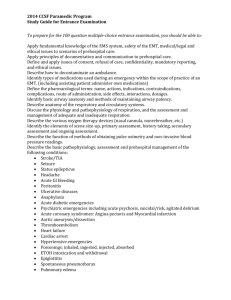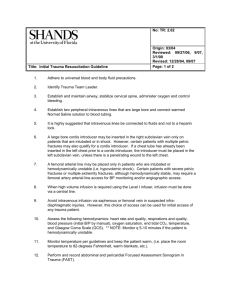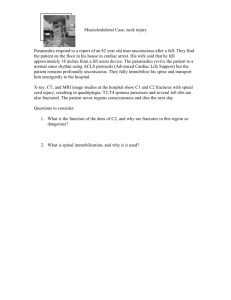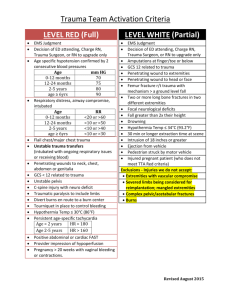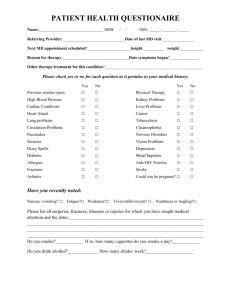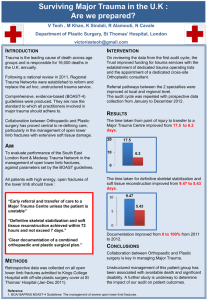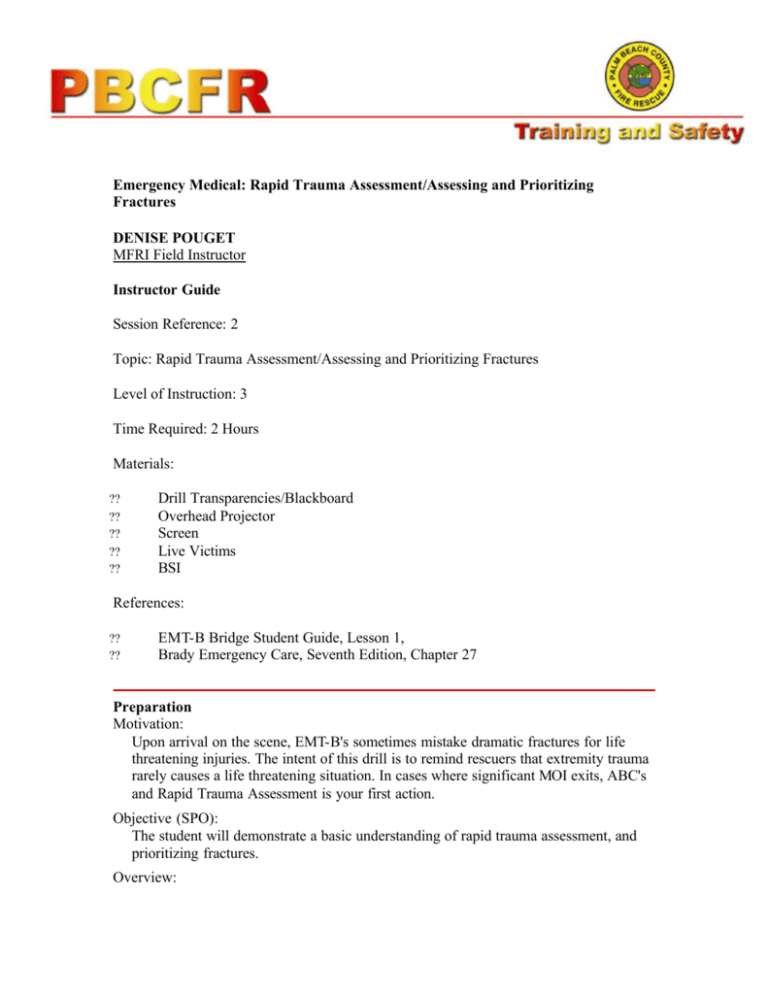
Emergency Medical: Rapid Trauma Assessment/Assessing and Prioritizing
Fractures
DENISE POUGET
MFRI Field Instructor
Instructor Guide
Session Reference: 2
Topic: Rapid Trauma Assessment/Assessing and Prioritizing Fractures
Level of Instruction: 3
Time Required: 2 Hours
Materials:
??
??
??
??
??
Drill Transparencies/Blackboard
Overhead Projector
Screen
Live Victims
BSI
References:
??
??
EMT-B Bridge Student Guide, Lesson 1,
Brady Emergency Care, Seventh Edition, Chapter 27
Preparation
Motivation:
Upon arrival on the scene, EMT-B's sometimes mistake dramatic fractures for life
threatening injuries. The intent of this drill is to remind rescuers that extremity trauma
rarely causes a life threatening situation. In cases where significant MOI exits, ABC's
and Rapid Trauma Assessment is your first action.
Objective (SPO):
The student will demonstrate a basic understanding of rapid trauma assessment, and
prioritizing fractures.
Overview:
Rapid trauma assessment, and assessing and fractures
??
??
??
??
Introduction
Rapid PA
Prioritizing fractures
Principles of treating fractures
Session 1
Rapid Trauma Assessment and Prioritizing Fractures
SPO 1- Describe the indications for performing a rapid trauma
1 assessment
1-2 Describe in order how to perform a rapid trauma
assessment
1-3 Describe how to prioritize fractures
1-4 List the general principles for the management of
suspected fractures or dislocations
Instructional Guide
1. Introduction
1. EMT-B's responding to incidents with a report of significant Mechanism
of Injury, should be prepared to perform the following basic objectives:
1. Scene Survey
2. Simultaneous Actions (LOC, c-spine, jaw thrust)
3. Assessment of the airway
4. Assessment of breathing
5. Possible support of ventilation/supplemental 02
6. Assessment of circulation
7. Control bleeding
8. DCAP-BTLS patients entire body (Fx assessed and stabilized)
9. Determine if patient is a critical trauma
10. Load and go/ or treat patient at scene
11. Baseline vitals
12. SAMPLE HISTORY
13. Detailed physical exam
14. Ongoing assessment(en route to trauma center)
15. Note: It is important to do a scene size up prior to starting patient
care. Depending on the number of victims, and the MOI, your
treatment can drastically change from incident to incident.
2. Rapid patient assessment
1. SCENE SURVEY
1. Body substance isolation
2. Scene safety/ Hazards
3. Determine MOI or NOI (mechanism of injury or nature of illness).
4. How many victims?
5. Are other resources needed?
2. SIMULTANEOUS ACTIONS
1. Determine LOC using the following scale:
1. A=Alert
2. V=Responds to verbal stimulus
3. P=Responds to painful stimulus
4. U=Unresponsive
2. Manually immobilize C-spine
1. Jaw thrust to establish airway if necessary
3. Assessment of AIRWAY
1. Jaw thrust needed?
2. Is airway open?
3. Inspect for foreign bodies
4. Need suctioning?
5. Consider airway adjunct
4. Assessment of BREATHING
1. Is it present?
2. Approximate rate
3. Character of respirations
4. Are respirations adequate?
5. Supporting VENTILATIONS
1. Give 15 lpm O2 via NRB if rate is greater than 8 and breathing is
adequate
2. Bag Valve Mask w/reservoir and 15 lpm O2 at 24 per minute if:
1. Respiratory rate less than 8
2. Breathing is inadequate
3. Head trauma is suspected
6. Assessment of CIRCULATION
1. Carotid pulse
1. Present?
2. Approximate rate?
3. Character?
2. What is the general skin color and temperature?
7. CONTROL BLEEDING>
8. ASSESS THE HEAD (quickly through) DCAP-BTLS for obvious injury
(inspect and palpate)
1. Deformity
2. Contusions
3. Abrasions
4. Punctures/penetrations
5. Burns
6. Tenderness
7. Lacerations
8. Swelling
9. Assess the NECK (anterior and posterior) DCAP-BTLS
1. Trachea: midline or deviated?
2. Jugular veins distended or flat?
3. Any signs of trauma?
4. Stoma?
5. Medic Alert Tag?
6. Apply a cervical spinal immobilization collar
10. Assess the CHEST
1. Expose, inspect and palpate the chest DCAP-BTLS
2. Auscultate Chest Bilaterally
1. Mid-clavicular
2. Mid-axillary
3. Compare sounds from side to side
3. Heart sounds
1. Present?
2. Same rate as pulse?
11. Expose, inspect and palpate abdomen DCAP–BTLS
1. Firm or Soft
2. Distended
12. Expose, inspect and palpate pelvis with gentle pressure downward and
inward DO NOT ROCK! DCAP-BTLS
13. Expose, inspect and palpate LOWER EXTREMITIES DCAP-BTLS
1. Distal pulses
2. Motor function
3. Sensory function
14. CRITICAL TRAUMA SITUATIONS appropriate to LOAD and GO.
1. Stabilize patient on a spine board. Treat non-life threatening
injuries en route. Do not waste time on the scene.
15. ASSESS BASE LINE VITALS, but do not delay critical treatment or
transport. They can be done en route.
1. Pulse
2. Respirations
3. Blood pressure
4. Skin color, temperature, moisture
5. Pupils
16. SAMPLE HISTORY
1. Symptoms and signs
2. Allergies
3. Medications
4. Past illness
5. Last Meal
6. Events prior
17. Detailed Physical Examination en route to trauma center (old secondary
survey).
18. Repeat and record findings of initial assessment every five minutes
3. Prioritizing and assessing extremity fractures
1. Problems that demand care before joint and bone injuries
1. Airway
2. Breathing
3. Circulation
4. Disability
5. Shock
6. Neck and spinal injuries
7. Open chest wounds
8. Open abdominal wounds
9. Serious burns
2. Priority of care for fractures
1. Fractures of the spine
2. Fractures of the head, rib cage, and pelvis
3. Fractures of the extremities
3. Priority of care for extremity fractures
1. Lower extremities before upper extremities
2. Pelvis
3. Femurs
4. Joints
5. Long bones
4. General Principles for management of suspected fractures or dislocations
1. Assessment and treatment of the fracture
1. Calm and reassure the patient.
2. Recognize and assess fracture or dislocatio n.
3. Cut away clothing and remove jewelry from the injury site.
4. Splint fractures in a manner that immobilizes the joint above and
below the fracture site.
5. All fractures should be splinted in the position of function without
using excessive force or causing the patient to experience extreme
pain.
6. Distal pulses and neurological function should be checked before
and after splinting.
7. Straighten angulated fractures of long bones with gentle traction
prior to splinting.
8. Cover all open wounds with sterile dressings prior to application of
a splint.
9. Pad all splints to prevent excessive pressure.
10. Apply cold packs to ischemic fractures, from site of injury to distal
end.
11. Immobilize fractures prior to movement of the patient.
12. Leave fingers and toes exposed if possible.
13. Wrap extremities distal to proximal.
14. Splints should not impair circulation
15. Elevate the extremities following immobilization where possible
(not if the patient has a potential c-spine injury).
16. kling is used for upper extremity fractures, and 6" kling is used for
lower extremity fractures.
17. When in doubt, SPLINT.
SUMMARY
Review:
Rapid Trauma Assessment/Assessing and Prioritizing Extremity Fractures
1.
2.
3.
4.
Introduction
Rapid PA
Prioritizing fractures
Principles of treating fractures
Remotivation:
EMT-B's responding to incidents with a report of significant MOI should be prepared to
triage, and do rapid patient assessment. Remember that extremity trauma may look
dramatic, however, it is rarely life threatening.
Assignment:
Create mock situations giving victims significant mechanism of injury. Assign
each victim two life threatening injuries, and four extremity fractures.
Evaluation:
Students should demonstrate a rapid trauma assessment, and tell the instructor the
priority of all fractures found during the assessment.
Copyright © 1998 Maryland Fire and Rescue Institute. All rights reserved.



